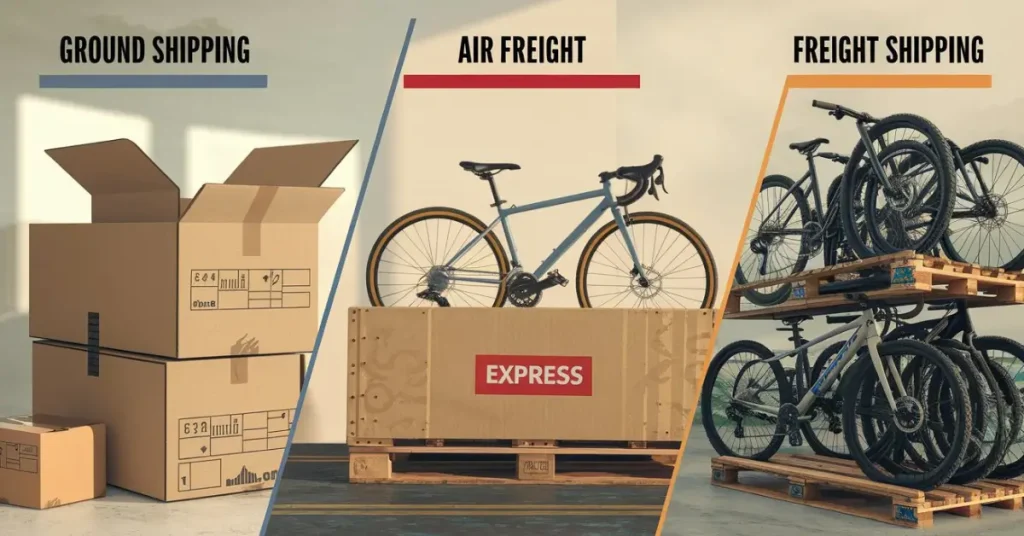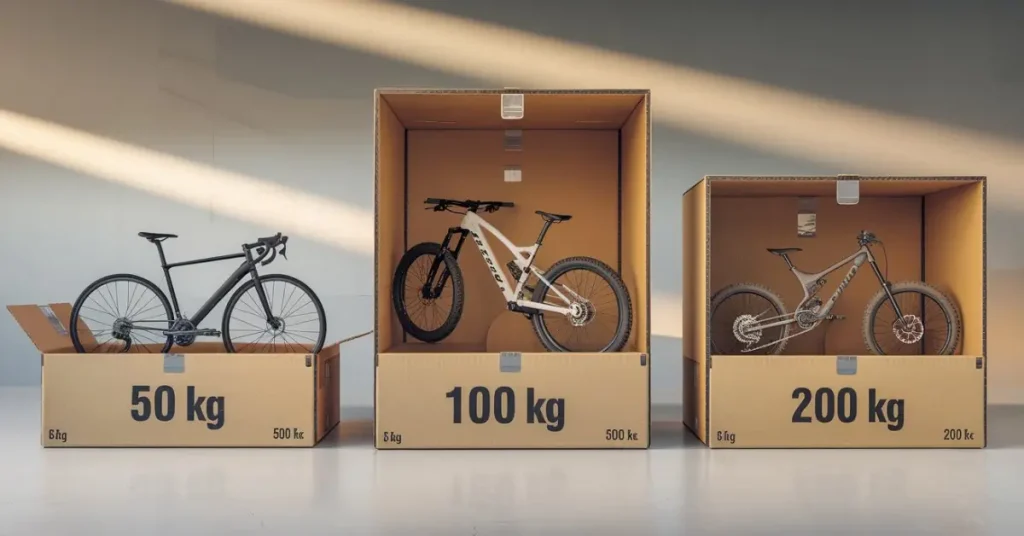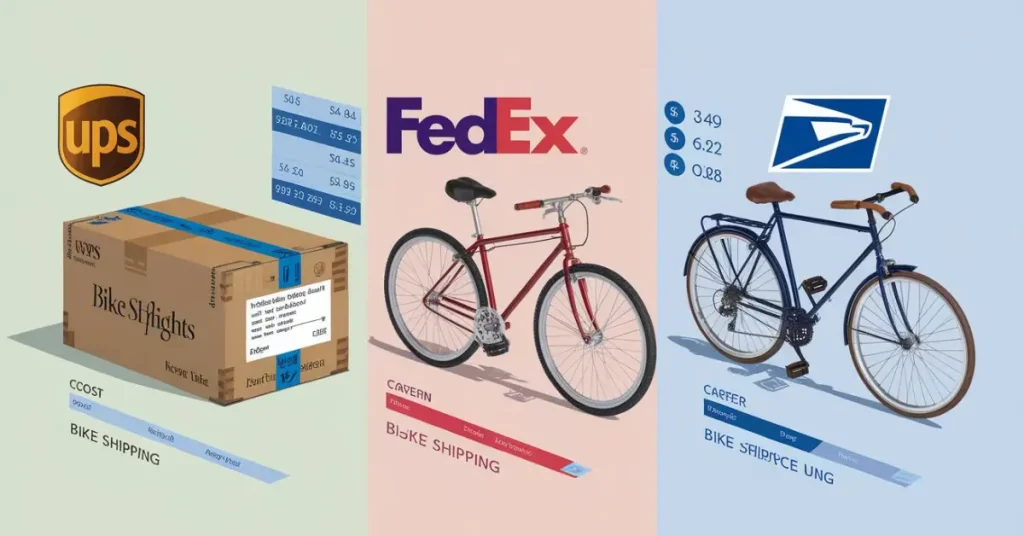Ever wondered, how much to ship a bike? Whether you’re moving cross-country, selling a bike online, or gearing up for a dream cycling trip, figuring out shipping costs can feel like solving a puzzle. I’ve been there—staring at carrier price charts, wondering if it’s cheaper to box up my bike or just ride it there myself. The truth? Costs vary wildly depending on the shipping method, carrier, and whether you’re sending a road bike, mountain bike, or even a dirt bike. In this guide, I’ll break it all down—from UPS and FedEx bike shipping costs to the cheapest way to ship a bike internationally. Let’s make sure you get the best deal without the hassle!
Factors Affecting the Cost of Shipping a Bike

Shipping a bike may seem straightforward at first, but let me tell you from experience, it’s a bit more nuanced than simply tossing it in a box. Over the years, I’ve shipped bikes for all sorts of reasons—whether moving across the country, selling a bike online, or racing in a different city—and I’ve learned that the cost can vary based on several factors. Here’s what you need to know before you pull out your wallet.
A. Shipping Method & Carrier

The method you choose to ship your bike will be the most significant factor in how much it costs. Let me walk you through some of the common options:
Ground Shipping (Cheapest but slower):
When I shipped my road bike from New York to California with FedEx Ground, it cost me about $120. It was a pretty smooth experience, but it did take about a week to get there. If you’re not in a rush, ground shipping is hands down the most affordable option, usually costing anywhere from $50 to $150 domestically. It’s reliable but slower—expect anywhere from 5 to 10 days depending on your destination.
Air Freight (Fast but expensive):
Now, if you’re in a real hurry, air freight is your go-to. When I had to get a bike to a competition the next day, I used FedEx Express. It was fast—got there in a day—but cost me about $300 for domestic shipping. If you’re looking to ship internationally, you might be looking at upwards of $1,500 depending on the carrier, such as FedEx Air or UPS Express. Air freight is the fastest, but it’s definitely not the most budget-friendly choice.
Freight Shipping (Best for multiple bikes):
When you’re shipping more than one bike or something bulky, freight shipping becomes the best solution. I once used a service like BikeFlights to ship multiple bikes across the country. It cost me about $150 per bike, which wasn’t too bad considering how many I had to ship. Services like BikeFlights and ShipBikes specialize in these larger shipments, offering discounted rates for bulk shipping. You’re typically looking at $70 to $200 domestically and $150 to $400 for international shipments.
International Shipping (Expensive due to customs & taxes):
International shipping is a whole different ballgame. Not only are you dealing with the long distance, but you also need to consider customs fees, taxes, and import regulations. I shipped a bike to Europe once, and it cost around $250. For quicker international shipments, expect to pay between $300 and $500. However, shipping to destinations like Australia or Japan can get even more expensive. Always check the latest rates, as these can fluctuate.
B. Size & Weight of the Bike

Standard VS. Oversized Bikes:
If you’re shipping a standard road bike, you’re in luck—it’s typically lightweight and compact, so shipping costs will be on the lower end. Mountain bikes and dirt bikes, on the other hand, are much bulkier and heavier. I remember shipping my mountain bike, and the cost was about $100 higher than when I shipped my road bike, just because of its added weight and size.
Dimensional Weight Considerations:
Here’s a sneaky thing I learned: Shipping carriers often use “dimensional weight” to calculate shipping costs. This means that the box size can actually increase the cost, even if the bike itself isn’t heavy. For example, I once shipped a bike in a massive box, and the price shot up because of the size, not just the weight. So, when you pack your bike, try to use the smallest box possible.
Disassembly & Packaging Tips:

Disassembling your bike is key to saving money. Take off the pedals, wheels, and seat post to reduce the box size. I’ve shipped bikes both fully assembled and disassembled, and the disassembled version was always cheaper. Also, don’t skimp on padding! Protecting your bike with foam or bubble wrap is crucial. When I first shipped my bike, I didn’t pack it well, and the frame got scratched. Ever since, I’ve made sure to pack it properly to avoid damage.
C. Distance & Destination
The distance your bike has to travel plays a huge role in the cost.
Local VS. Cross-Country Shipping:
Shipping a bike locally is much cheaper. For instance, I once shipped a bike from Florida to Georgia for just $50 using USPS. However, when you’re shipping cross-country, like from New York to California, the costs jump to around $80 to $200 depending on your chosen method.
International Shipping Fees:
Once you go international, the price skyrockets. For example, shipping a bike to Europe can cost anywhere from $150 to $300, and if you’re sending it to places like Japan or Australia, you might be looking at $200 to $400. Keep in mind that customs duties and import taxes will add more to the cost, and those can vary depending on where you’re sending it.
D. Additional Services & Fees
There are a few extra charges that can sneak in and impact your bike’s shipping cost.
Insurance:
If you’ve got an expensive bike, consider adding insurance. Basic coverage usually covers only $100 to $300, so if your bike is worth more than that, you’ll need to buy additional insurance. I shipped a custom bike once and made sure to buy extra coverage because it was far more valuable than the basic $300 coverage.
Express Delivery & Signature Confirmation:
If you need your bike to arrive fast, express shipping is the way to go, but it’s going to cost more—typically between $150 and $300 domestically. For international shipments, this could go even higher. And if you want to ensure the bike gets to the right person, adding signature confirmation (to ensure someone signs for the delivery) can add an extra cost.
Packaging Assistance from Carriers:
Some carriers will provide packaging assistance, offering bike boxes and packing materials for an additional fee. While this can be convenient, I’ve found it’s usually cheaper (and more personal) to get a free bike box from a local shop. But, if you’re in a time crunch or shipping internationally, these services can be a lifesaver.
How Much Does It Cost to Ship a Bike?

Shipping a bike isn’t as simple as just throwing it in a box. Over the years, I’ve shipped bikes for all sorts of reasons: moving, selling, and even just to race across the country. Let me tell you, costs can vary widely, and there’s a lot more to consider than just the distance. Whether you’re a first-time shipper or an experienced cyclist, I’ll walk you through the main factors that can affect your shipping costs and give you the real numbers, so you can get your bike to its destination without breaking the bank.
A. Estimated Costs for Different Shipping Methods
When it comes to shipping a bike, the method you choose is the biggest factor in determining the price. Based on my own experiences, here’s a breakdown of what you can expect to pay for the most common shipping methods:
UPS Ground
- Domestic: $50 – $150
- International: $150 – $300
UPS Ground is what I’ve used for local moves, and it’s one of the most cost-effective options out there. For cross-country shipping, expect to pay on the higher end of the spectrum—especially if your bike is on the bulky side.
FedEx Ground
- Domestic: $50 – $140
- International: $150 – $350
FedEx is another reliable option. I once shipped a road bike from New York to California via FedEx Ground, and it cost about $120. For smaller, lighter bikes, it’s a great choice.
USPS (Best for lightweight bikes)
- Domestic: $40 – $100
- International: $100 – $400
USPS is perfect for smaller, lighter bikes like kids’ bikes or folding bikes. When I shipped a lightweight bike to my cousin in Georgia, it only cost $50. It’s also an affordable option for international shipments, but it can take a bit longer.
DHL (Best for international shipping)
- Domestic: Varies
- International: $200 – $500
I’ve used DHL for international shipments, and I have to say, it’s the best choice when you’re sending a bike overseas. When I shipped to Europe, the cost was around $250, which wasn’t the cheapest, but it got there in just a few days.
BikeFlights & ShipBikes
- Domestic: $70 – $200
- International: $150 – $400
For a more specialized option, services like BikeFlights and ShipBikes provide solid deals, especially for international shipments. These services offer bike-specific packaging and insurance options, which is a huge peace of mind for cyclists like me who are shipping valuable bikes.
Air Freight (FedEx, UPS, DHL)
- Domestic: $200 – $600
- International: $500 – $1,500
Air freight is perfect if you’re in a rush, but let me warn you—it’s expensive. I once needed my bike to get to a competition the next day, and although I was cringing at the $300 cost, it was worth it for the speed. Expect international air freight to cost a lot more, especially if you’re shipping a bike to a far-off destination like Australia or Japan.
B. Cost Examples by Distance
The distance your bike has to travel plays a huge role in the final shipping cost. Here’s a rough idea of how much you can expect based on the shipping distance:
Short-Distance Shipping (Same State or Nearby States)
- $40 to $80
Shipping a bike within the same state or a nearby state is usually pretty cheap. I shipped a bike from Florida to Georgia once for only $50 with USPS. It was fast and easy—no complaints.
Cross-Country Shipping (e.g., California to New York)
- $80 to $200
Now, when you’re talking cross-country, the costs go up a little. When I shipped a bike from New York to California, I used FedEx Ground and paid around $120. It’s still affordable compared to air freight, but keep in mind that longer distances will add up.
International Shipping (e.g., USA to Europe)
- $150 to $400
For international shipments, you’re looking at $150 to $300 to get your bike to Europe. I’ve shipped to Europe a few times, and it usually costs me around $250 with DHL. If you’re shipping to Europe, expect something in this ballpark, but prices vary based on the destination country.
International Express (e.g., USA to Australia)
- $300 to $500
If you’re shipping to places like Australia or Japan, the price tends to be on the higher end. Express shipping costs between $300 and $500 depending on the urgency and the carrier. I’ve shipped bikes internationally for races, and let me tell you—when you need it there fast, you’ll definitely pay more.
Tips to Save Money on Shipping

Now that you have a rough idea of the costs, let’s talk about how to save some cash when shipping your bike:
- Use Ground Shipping for Domestic Moves: If you’re not in a hurry, ground shipping is by far the cheapest. I always choose UPS Ground or FedEx Ground when I need to ship a bike across the U.S.
- Disassemble Your Bike: Take off the pedals, wheels, and seat post to reduce the box size and weight. It’ll help cut down on the cost significantly. When I shipped my mountain bike disassembled, it was $100 cheaper than shipping it fully assembled.
- Shop Around: Don’t just go with the first carrier. Compare rates from FedEx, UPS, USPS, and BikeFlights to see which one offers the best deal for your bike.
- Consider Bike-Specific Shipping Services: If you’re shipping multiple bikes or a high-value bike, services like BikeFlights and ShipBikes are great options. They often provide better packaging and insurance coverage.
- Watch for Seasonal Discounts: Carriers sometimes offer discounts during the off-season, especially in the winter months. If you can plan ahead, you might snag a better deal.
Final Thoughts
Shipping a bike can seem complicated, but it doesn’t have to be a headache. By understanding the factors that influence the cost, like shipping method, distance, and bike size, you can make smarter decisions that save you money. Don’t forget to compare carriers, consider bike-specific shipping services, and always disassemble your bike for a more affordable shipping experience.
Next time you’re ready to ship a bike, whether it’s for a move, a race, or to sell, you’ll be prepared and know exactly what to expect with your shipping costs. Safe travels for your bike! 🚲✈️
How Much Does It Cost to Ship a Bike?

Shipping a bike isn’t as simple as just throwing it in a box. Over the years, I’ve shipped bikes for all sorts of reasons: moving, selling, and even just to race across the country. Let me tell you, costs can vary widely, and there’s a lot more to consider than just the distance. Whether you’re a first-time shipper or an experienced cyclist, I’ll walk you through the main factors that can affect your shipping costs and give you the real numbers, so you can get your bike to its destination without breaking the bank.
A. Estimated Costs for Different Shipping Methods
When it comes to shipping a bike, the method you choose is the biggest factor in determining the price. Based on my own experiences, here’s a breakdown of what you can expect to pay for the most common shipping methods:
UPS Ground
- Domestic: $50 – $150
- International: $150 – $300
UPS Ground is what I’ve used for local moves, and it’s one of the most cost-effective options out there. For cross-country shipping, expect to pay on the higher end of the spectrum—especially if your bike is on the bulky side.
FedEx Ground
- Domestic: $50 – $140
- International: $150 – $350
FedEx is another reliable option. I once shipped a road bike from New York to California via FedEx Ground, and it cost about $120. For smaller, lighter bikes, it’s a great choice.
USPS (Best for lightweight bikes)
- Domestic: $40 – $100
- International: $100 – $400
USPS is perfect for smaller, lighter bikes like kids’ bikes or folding bikes. When I shipped a lightweight bike to my cousin in Georgia, it only cost $50. It’s also an affordable option for international shipments, but it can take a bit longer.
DHL (Best for international shipping)
- Domestic: Varies
- International: $200 – $500
I’ve used DHL for international shipments, and I have to say, it’s the best choice when you’re sending a bike overseas. When I shipped to Europe, the cost was around $250, which wasn’t the cheapest, but it got there in just a few days.
BikeFlights & ShipBikes
- Domestic: $70 – $200
- International: $150 – $400
For a more specialized option, services like BikeFlights and ShipBikes provide solid deals, especially for international shipments. These services offer bike-specific packaging and insurance options, which is a huge peace of mind for cyclists like me who are shipping valuable bikes.
Air Freight (FedEx, UPS, DHL)
- Domestic: $200 – $600
- International: $500 – $1,500
Air freight is perfect if you’re in a rush, but let me warn you—it’s expensive. I once needed my bike to get to a competition the next day, and although I was cringing at the $300 cost, it was worth it for the speed. Expect international air freight to cost a lot more, especially if you’re shipping a bike to a far-off destination like Australia or Japan.
B. Cost Examples by Distance
The distance your bike has to travel plays a huge role in the final shipping cost. Here’s a rough idea of how much you can expect based on the shipping distance:
Short-Distance Shipping (Same State or Nearby States)
- $40 to $80
Shipping a bike within the same state or a nearby state is usually pretty cheap. I shipped a bike from Florida to Georgia once for only $50 with USPS. It was fast and easy—no complaints.
Cross-Country Shipping (e.g., California to New York)
- $80 to $200
Now, when you’re talking cross-country, the costs go up a little. When I shipped a bike from New York to California, I used FedEx Ground and paid around $120. It’s still affordable compared to air freight, but keep in mind that longer distances will add up.
International Shipping (e.g., USA to Europe)
- $150 to $400
For international shipments, you’re looking at $150 to $300 to get your bike to Europe. I’ve shipped to Europe a few times, and it usually costs me around $250 with DHL. If you’re shipping to Europe, expect something in this ballpark, but prices vary based on the destination country.
International Express (e.g., USA to Australia)
- $300 to $500
If you’re shipping to places like Australia or Japan, the price tends to be on the higher end. Express shipping costs between $300 and $500 depending on the urgency and the carrier. I’ve shipped bikes internationally for races, and let me tell you—when you need it there fast, you’ll definitely pay more.
Tips to Save Money on Shipping
Now that you have a rough idea of the costs, let’s talk about how to save some cash when shipping your bike:
- Use Ground Shipping for Domestic Moves: If you’re not in a hurry, ground shipping is by far the cheapest. I always choose UPS Ground or FedEx Ground when I need to ship a bike across the U.S.
- Disassemble Your Bike: Take off the pedals, wheels, and seat post to reduce the box size and weight. It’ll help cut down on the cost significantly. When I shipped my mountain bike disassembled, it was $100 cheaper than shipping it fully assembled.
- Shop Around: Don’t just go with the first carrier. Compare rates from FedEx, UPS, USPS, and BikeFlights to see which one offers the best deal for your bike.
- Consider Bike-Specific Shipping Services: If you’re shipping multiple bikes or a high-value bike, services like BikeFlights and ShipBikes are great options. They often provide better packaging and insurance coverage.
- Watch for Seasonal Discounts: Carriers sometimes offer discounts during the off-season, especially in the winter months. If you can plan ahead, you might snag a better deal.
Final Thoughts
Shipping a bike can seem complicated, but it doesn’t have to be a headache. By understanding the factors that influence the cost, like shipping method, distance, and bike size, you can make smarter decisions that save you money. Don’t forget to compare carriers, consider bike-specific shipping services, and always disassemble your bike for a more affordable shipping experience.
Next time you’re ready to ship a bike, whether it’s for a move, a race, or to sell, you’ll be prepared and know exactly what to expect with your shipping costs. Safe travels for your bike!
Cheapest Way to Ship a Bike

Shipping a bike can get pricey, but don’t panic! I’ve shipped bikes many times, and through trial and error, I’ve picked up some tricks to save you money. Whether you’re moving, selling, or taking your bike on a big adventure, there are ways to keep costs down without sacrificing safety. Let’s dive into the most budget-friendly options.
A. Tips for Reducing Bike Shipping Costs
- Use UPS Ground or FedEx Ground for Affordability When it comes to domestic shipping, UPS Ground and FedEx Ground are your best bets. I shipped my bike from New York to California with FedEx Ground for just $120. It was reliable and didn’t break the bank, though it did take about a week to get there. Ground shipping is generally the most affordable choice, ranging from $50 to $150 domestically. If you don’t need your bike there super fast, this is a solid pick.
Pro Tip: Book in advance whenever possible. Last-minute shipping costs can surge, especially during peak seasons. The more you plan, the more you’ll save.
- Disassemble Your Bike and Pack It Smart One thing I learned the hard way: packing matters. The smaller the box, the cheaper it will be to ship. I once saved about $100 on a mountain bike shipment just by taking off the pedals, wheels, and seat post. It doesn’t take long, and it really cuts down on both dimensional weight (which carriers charge based on box size) and shipping costs. If you pack your bike like a pro, you’ll be amazed at the difference it makes.
- Reuse Free Bike Boxes Don’t shell out money for a new box when you can get one for free! I’ve picked up several bike boxes from local bike shops, and they work perfectly. Sure, it may take a little extra effort to ask around, but it’s worth it. The money you save on packaging can go towards something else, like a cool new helmet or some gear. So, before you buy packaging, ask your local shop—they’re usually happy to hand out free boxes.
- Look for Bike-Specific Shipping Services (BikeFlights & ShipBikes) When I needed to ship multiple bikes, I turned to BikeFlights. They specialize in bike shipping, so the service is tailored to our needs as cyclists. They offer discounted rates and bike-specific packaging, which makes it both safe and affordable. Even though they can be pricier than UPS or FedEx Ground, I found that they’re usually worth it when you’re shipping a high-value bike or multiple bikes.
- Consider Amtrak Express for Budget-Friendly Shipping (Where Available) Did you know Amtrak lets you ship bikes? I was shocked when I first found out, but it’s a seriously cost-effective option—especially for longer domestic moves. Amtrak Express charges a flat rate for bikes, which can save you a lot compared to traditional shipping services. Of course, this only works if you’re moving to or from a city along their routes, but if you’re in luck, it could be your cheapest option!
B. Cheapest International Bike Shipping Options
- Use DHL or USPS Priority Mail International for Affordability For international shipping, USPS Priority Mail International is often the most affordable, especially for lighter bikes. I’ve shipped bikes to Europe using USPS and paid around $250—which is a great deal when you consider that some carriers charge twice that. The downside? It can take a little longer, but if you’re not in a rush, this is an excellent budget choice.
- Ship via Ocean Freight for Large Shipments If you’re sending more than one bike internationally, ocean freight can be a game-changer. It’s significantly cheaper than air freight, though it takes longer. I’ve used this method when I had multiple bikes to ship to a race overseas. Ocean freight usually costs around $200 to $500 per bike, depending on the destination and size. Just keep in mind, if you’re looking for a quick turnaround, this isn’t your best option. But if you’ve got time and are shipping in bulk, ocean freight is definitely the way to go.
Pro Tip: Always check for seasonal discounts with your carrier. Especially during the off-season, like winter, you can often find special promotions or discounted rates that might make shipping cheaper than expected. It pays to keep an eye on those deals!
Final Thoughts
The key to shipping your bike cheaply comes down to planning ahead, choosing the right shipping method, and being smart about packing. Whether you’re sending it across the country or overseas, using ground shipping, disassembling your bike, and considering specialized services like BikeFlights or USPS can all help keep your costs down.
Next time you’re ready to ship your bike, you’ll have all the tips and tricks to make it as affordable as possible—without any surprises. Safe travels to your bike!
How to Ship a Bike: Step-by-Step Guide

Shipping a bike doesn’t have to be as overwhelming as it sounds. Sure, it may seem like a big task at first, but with a little preparation and some insider knowledge, you’ll be all set. I know firsthand that it can be a bit daunting, especially if you’re shipping a bike for the first time, but I’ve been there, done that, and I’m here to walk you through it with a step-by-step guide.
A. Packing a Bike for Shipping

Let’s start with the most important part: packing your bike. If you do it right, it will save you a ton of money and keep your bike safe during the journey. Trust me, I’ve learned a lot from mistakes along the way, and proper packing can make a huge difference!
- Disassemble the Bike: Before you even think about boxing your bike, you’ll want to disassemble it. This is a game-changer when it comes to reducing the cost of shipping. For example, when I shipped my mountain bike, I took off the pedals, handlebars, seat post, and wheels. This made the bike smaller and much lighter. In fact, it saved me about $100 compared to shipping it fully assembled.
- Protect Fragile Parts: The next step is all about protection. You don’t want your bike arriving with scratches or dents! I use foam tubing to wrap around the frame and fork, then layer bubble wrap for extra protection. It might sound like overkill, but I once shipped a bike without enough padding, and the frame got scratched up. Never again! The foam and bubble wrap are worth every penny.
- Secure All Parts: Now, it’s time to secure everything in place. I use zip ties to keep smaller parts like the wheels and handlebars from shifting around. I’ve learned the hard way that if you don’t secure things properly, they’ll bang against each other in transit, causing damage.
- Use a Durable Bike Box: Finding a good bike box is key. The standard size for most bikes is around 54” x 8” x 28”, but it’s always a good idea to double-check your bike’s dimensions before buying a box. I usually grab mine for free at local bike shops. Most shops are more than happy to give you one. No need to pay for new boxes if you don’t have to!
- Label the Box Properly: I can’t stress this enough—label your box clearly! I’ve had a package get lost because the label wasn’t legible enough. Write your name, address, and phone number clearly in big, bold letters. Trust me, it’s worth the extra effort to ensure it arrives safely.
B. Choosing a Carrier & Booking a Shipment
Alright, now that your bike’s packed, it’s time to choose the right carrier. The cost and the delivery time can vary a lot depending on your choice, so here’s what I’ve learned from my experiences.
- Compare Rates: The first rule of bike shipping is: don’t just go with the first carrier you find. Always shop around and compare rates between FedEx, UPS, USPS, DHL, and services like BikeFlights or ShipBikes. For instance, I saved about $20 when I shipped a bike from New York to California by choosing FedEx Ground over UPS.
- Enter Package Dimensions: Once you have a carrier in mind, you’ll need to enter the weight and dimensions of your bike package. Don’t worry about being super exact; the carrier’s shipping calculator will help you estimate costs based on the bike’s size and weight.
- Select the Shipping Method & Extra Services: Now, pick the shipping speed that works best for you. If you need it fast, air freight is your best bet (though it’s more expensive). If you’re shipping a valuable bike, don’t skip the insurance. I always opt for it when shipping my more expensive bikes. It adds a little cost, but it’s totally worth it for peace of mind.
- Print and Attach the Shipping Label: After you’ve finalized everything, you’ll get a shipping label. Make sure to print it out and securely attach it to the box. I always double-check this step because there’s nothing worse than realizing you forgot the label after it’s already on its way!
C. Dropping Off vs. Scheduling a Pickup
Now that your bike is packed, and the label is on, you have two options: drop it off at a carrier location or schedule a pickup.
- Drop It Off: I find that dropping off the bike at a carrier location is the most straightforward and cost-effective option. Whether it’s FedEx, UPS, or USPS, you can easily find drop-off locations. I personally like doing this because it gives me the peace of mind of seeing the process begin immediately.
- Schedule a Pickup: If you’re short on time or don’t have easy access to a drop-off location, most carriers offer pickup services for an additional fee. While this is super convenient, you’ll want to factor in the extra cost. I’ve used this service when shipping multiple bikes, and it saved me a lot of time, but keep in mind, you’ll pay more for the convenience.
Final Thoughts
Shipping a bike doesn’t have to be stressful or expensive! By following these steps—packing carefully, choosing the right carrier, and considering all your options—you can make sure your bike gets where it needs to go safely and affordably. I’ve shipped bikes all over the country and even internationally, and I can tell you that taking the time to prepare properly makes all the difference.
So, the next time you need to ship a bike, whether it’s for a race, a move, or just a sale, you’ll be equipped with everything you need to make it an easy, cost-effective process. Safe travels for your bike! 🚲✈️
FAQs About Shipping a Bike
How much does UPS charge to ship a bike?
If you’re shipping a bike domestically with UPS, expect to pay between $50 and $150, depending on the size, weight, and destination. For international shipments, the cost ranges from $150 to $400. I’ve used UPS a few times, and while they’re reliable, the price can get high for long distances.
Pro tip: Always check UPS rates for an accurate estimate before shipping.
Is it worth shipping a bike?
It depends on your bike. If it’s high-value or holds sentimental value, it’s worth it. I shipped a custom bike for a race, and it was totally worth it. But, if you’re shipping a cheaper or older bike, buying a new one locally might be smarter. If it’s a second-hand bike from a sale, you might want to leave it behind and buy a new one when you get there.
How much does it cost to ship a bike FedEx?
FedEx Ground is a solid choice. Domestic shipments typically cost $50 to $140, depending on size and distance. For international shipping, expect to pay $150 to $350. I shipped a road bike from New York to California for around $120. For bigger or heavier bikes, you might pay more.
What is the cheapest way to ship a bike internationally?
The most affordable international options are USPS Priority Mail International and DHL. USPS is great for lighter bikes and costs around $250 to Europe. However, it might take longer. If you need quicker delivery, DHL is faster but ranges from $200 to $500.
How much does it cost to ship a dirt bike?
Dirt bikes are bulky and heavy, so they cost more to ship. For domestic shipments, expect $250 to $600. Internationally, prices range from $500 to $1,500. I shipped a dirt bike across the country for $300 via a freight service, which was the most cost-effective choice.
How much to ship a bike to Europe?
Shipping to Europe usually costs $150 to $300 for standard shipping. If you’re in a hurry, express shipping will cost between $300 and $500. When I shipped a bike to the UK, it cost me $250 with DHL, which was a good deal for international shipping. Keep in mind that customs fees and taxes can add to the total cost.
Final Thoughts
Shipping a bike doesn’t need to be complicated or expensive. With the right planning and carrier choice, you can save money and ensure your bike’s safety. Compare rates, disassemble your bike to reduce costs, and make sure you’re getting the best deal.
Conclusion: How Much to Ship a Bike?
Shipping a bike doesn’t have to be a stressful or expensive process. After all the details we’ve gone over, let’s recap: the cost of shipping your bike can vary greatly depending on factors like shipping method, the size and weight of the bike, and where it’s headed. From domestic shipments that range between $40 and $200, to international shipments that can cost anywhere from $150 to $1,500, the price fluctuates depending on how fast you need it, and the type of service you choose.
Based on my own experience, I’ve found that the most cost-effective methods are UPS Ground and FedEx Ground—especially if you aren’t in a rush. I’ve shipped bikes cross-country for about $120 using FedEx Ground, and it’s a solid, affordable choice. If you need something more specialized, BikeFlights and ShipBikes are great options that offer bike-specific packaging and insurance, which can provide you peace of mind for a bit more of an investment. But remember, packing is key! Disassembling your bike can save you a lot in shipping costs by reducing its size and weight.
If you want to make sure you’re getting the best deal, don’t forget to compare rates from different services. Every carrier has a shipping calculator on their website, and it’s always a good idea to check before you commit.
When it comes to packing, I can’t emphasize this enough—pack smart! Take the time to remove pedals, wheels, and seats to reduce the size of your bike, and be sure to protect your bike with foam and bubble wrap. I’ve learned from experience that properly packing your bike can save you money and prevent your bike from arriving damaged.
To wrap up: Shipping a bike doesn’t need to break the bank. Whether you’re moving, racing, or selling a bike, planning ahead and packing properly will make the process smoother and more affordable. So, take the time to research your options, disassemble your bike, and use the right shipping method for your needs. And don’t forget, sometimes checking for seasonal discounts can make all the difference. Safe travels for your bike! 🚲✈️
Additional Resources for Shipping Your Bike
Alright, so now that we’ve gone through all the nitty-gritty details of shipping your bike, let’s talk about some resources that can really help you out. Trust me, these will save you time and a bit of that head-scratching moment when you’re trying to figure out which service to go with.
- FedEx Bike Shipping Cost Calculator
Okay, this one is a gem. I remember when I first needed to ship a bike across the country. I was standing in front of my computer, feeling like I was about to step into a pricing abyss. FedEx’s bike shipping calculator turned that around for me. You simply plug in your details, and bam—you get an estimate. It helps you plan without any surprises, and that feeling of “uh-oh” when you get the final bill? Gone. It’s easy, and it’s saved me a lot of stress! - UPS Shipping Rates
Now, let’s talk UPS. I’ve used UPS for a lot of my bike shipping, especially when I didn’t need it to be rushed. You can just pop your bike details into their shipping rate tool, and you’ll see the range of options. I’ve shipped bikes for around $120 across the U.S. with UPS Ground, and it worked out perfectly. It’s reliable, and while you can’t always go too fast, it’s usually a great balance of cost and service. You know the feeling when you find something you can trust? That’s what UPS feels like to me. - BikeFlights Bike Shipping Services
If you’re shipping multiple bikes or just want to be extra sure everything is packed right, I’ve got to say, BikeFlights is worth looking into. I used them for a big move with several bikes, and they made the whole process so smooth. They’re bike experts, so their packaging is tailored specifically to bikes, and their insurance options helped put my mind at ease. It’s not always the cheapest, but when it comes to something valuable (like that custom bike you’ve had for years), the extra care and attention are totally worth it. - USPS International Shipping Guide
For those of you who need to send your bike overseas but don’t want to sell your kidney to afford it, USPS is a solid choice. I’ve shipped a few bikes to friends in Europe using USPS Priority Mail International, and while it takes a little longer, the cost was way better than the express options. They even have a handy international shipping guide that gives you the rundown on taxes and customs. It’s one of those tools that makes you feel like you’re finally in the know when it comes to international shipments. - DHL Express International Shipping
Okay, for those times when you really need your bike to get there fast, DHL is a lifesaver. I remember shipping my bike to a race across the world, and DHL had it there quicker than I could say “race day.” They’re a bit on the pricier side, but if you’re in a pinch, they’re reliable, and they get the job done. They also have an easy-to-use shipping calculator, so you can plan ahead and see if you’re comfortable with the cost. It’s like that fast friend who always comes through when you’re running late.
These resources are your golden tickets to making the bike shipping process a breeze. Whether you’re sending it across the state, the country, or the globe, these tools have your back. And trust me, using the right resources makes all the difference. I’ve been there, stressing over which carrier to choose and if I’m getting the best deal—so I know how valuable these tools can be. Safe travels for your bike! 🚴♂️
Still have questions?
Drop a comment below! Our team is always here to support you.
Read Next…
